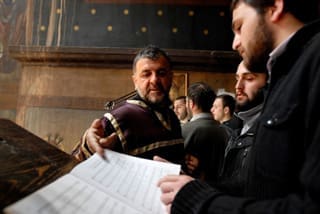High in the Caucasus Mountains, at the eastern end of the Black Sea, rests Georgia. Poised between the Arabic, Persian and Syriac cultures of Asia and the Greco-Roman world of the Mediterranean, Georgians have fashioned a unique civilization, integrating the some of the customs, ideas and traditions of these seemingly disparate societies with their own.
Christianity — which became the state religion in the eastern Georgian kingdom of Kartli by the fourth century — is as much responsible for the creation and survival of this distinctive nation as its unique language.
Strategically situated on this crossroads, tiny Georgia has repeatedly overcome far superior foes — Romans, Persians, Arabs, Mongols, Ottomans and Russians. And the Orthodox Church of Georgia, often described as the buttress of the nation, remains a formidable force in the lives of the country’s 4.7 million people, 84 percent of whom belong to the church.

Byzantine and Coptic histories note that St. Matthias the Apostle first brought the Gospel to the Georgian kingdom of Kartli and died a martyr’s death there around the year A.D. 80. Other Christian sources credit the apostles Andrew, Bartholomew, Simon the Zealot and Thaddeus with forming Christians among Georgia’s Jewish communities in Kartli and Egrisi, the western Georgian kingdom known by the ancient Greeks as Colchis — the mythical land of Jason, Medea and the Golden Fleece.Modern archaeological evidence — the remains of second- and third-century Christian tombs as well as early fourth-century churches — indicates an early presence of the faith, particularly near the Black Sea coast. That Christianity was the official religion of Kartli by the year 337 is incontestable. Armenian, Byzantine, Georgian, Greek and Latin sources all indicate that, in circa 300, Nino, a woman from Cappadocia, left Jerusalem for Kartli in search of the robe from Christ’s crucifixion.
“Equal to the apostles,” as Georgians revere her today, St. Nino worked primarily among the kingdom’s Jews, who were her first disciples. Written about a century after her death, “The Life of St. Nino” records the close relationship that existed between Nino and the Jews of Mtskheta (the capital of Kartli) as well as between the churches of Georgia and Jerusalem. It also details the conversion of King Mirian III, his establishment of Christianity as the faith of the kingdom and the erection of a shrine in Mtskheta to house the robe of Christ, known as the cathedral of Svetitskhoveli, or the “life-giving pillar.”
The “life-giving pillar” still stands in the heart of the nation, the bells summoning the faithful from Georgia’s mountains and valleys. To read more, click here.